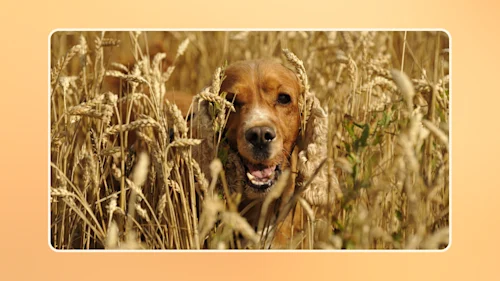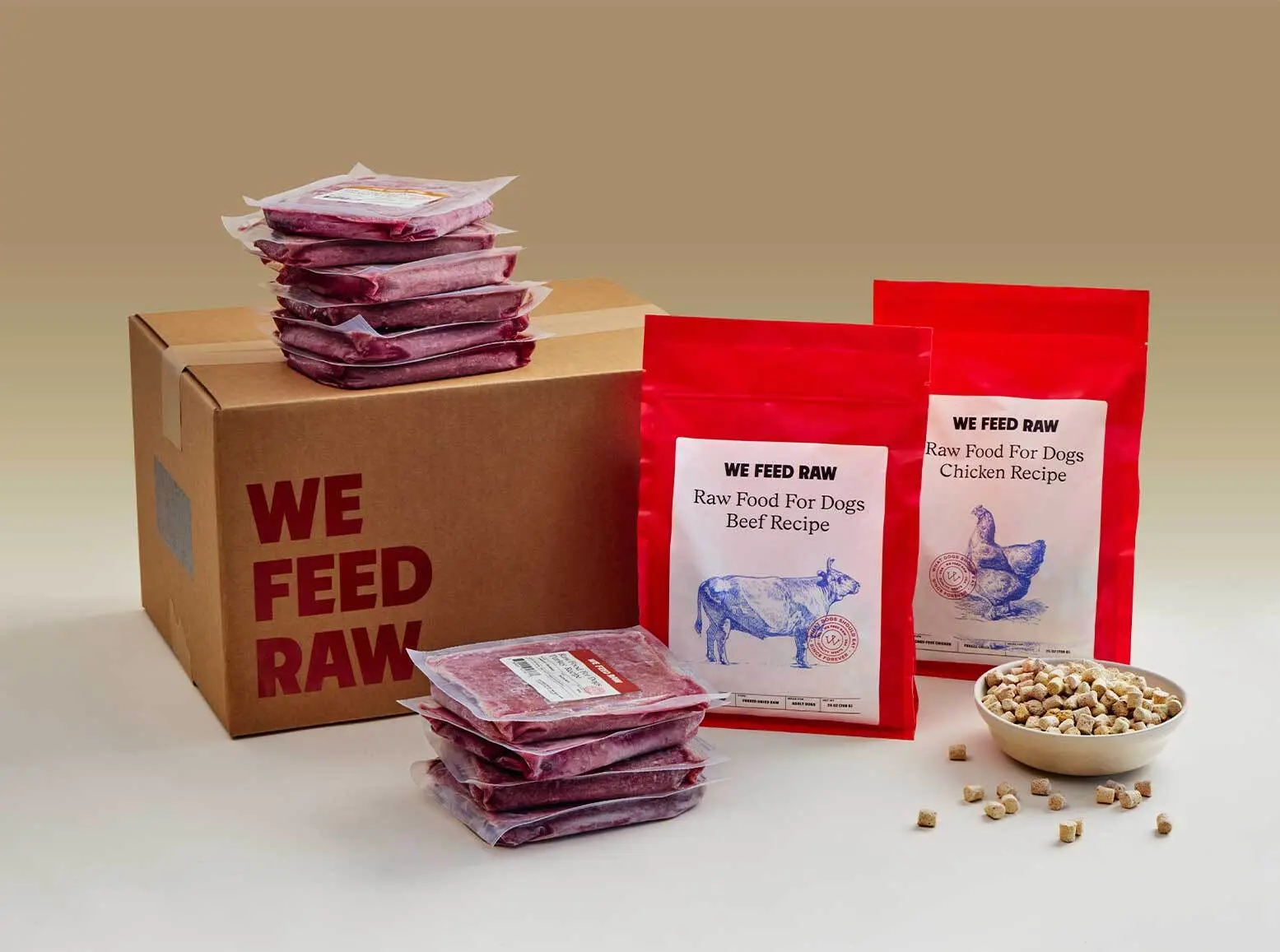
Best Grain Free Dog Food: A Guide to Raw Diets for Dogs
Table of Contents
- The Debate: Is Grain-Free Bad for Dogs?
- The Best Grain-Free Dog Food Options
- Are Grains Good for Dogs?
- Protein Quality in Grain-Free Diets
- Grain-Free vs. Grain-Inclusive Diets for Dogs
- Owner's Guide to Transitioning to Grain-Free Dog Food
- We Feed Raw Is the Best Grain-Free Dog Food
- Frequently Asked Questions (FAQs)
If you’re looking for the best grain-free dog food, you may have many questions. Is grain-free bad for dogs? Are grains good for dogs? Is grain-free dog food low in carbohydrates?
While dogs don’t need carbs in their diet, grain-free kibble often has at least as many carbs as grain-inclusive kibble, so for the best grain-free dog food, you have to think outside the kibble bag.
Keep reading to learn more about grain-free diets and why raw dog food is actually the best grain-free dog food available.
The Debate: Is Grain-Free Bad for Dogs?
In 2018, the US Food and Drug Administration (FDA) announced a potential connection between certain types of dog foods and an increased risk of a heart condition called dilated cardiomyopathy (DCM). While the concern was over foods containing high levels of peas, lentils, legumes, or potatoes, all grain-free dog foods came under fire since they were more likely to include those problematic ingredients than grain-inclusive formulations.
In December of 2022, the FDA announced that they would stop releasing public updates about the investigation into the potential link between diet and DCM “until there is meaningful new scientific information to share.”
While they have been unable to confirm any link between dog diet and DCM: “Most of the diets associated with the reports of non-hereditary DCM have legume seed ingredients, also called ‘pulses’ (e.g., peas, lentils, etc.), high in their ingredient lists…These include both ‘grain-free’ and grain-containing formulations.”
In other words, there is no evidence that a lack of grain in a dog’s diet contributes to an increased risk of DCM, although many commercial dog foods that are formulated to be grain-free include potentially problematic pulse ingredients.
Benefits of the Best Grain-Free Dog Food
While many “grain-free” dog foods contain potentially harmful lentils or peas, raw dog food is naturally grain-free and doesn’t contain problematic pulse ingredients. Dogs have no nutritional requirements for carbohydrates from grains or grain alternatives. In fact, carbohydrates may contribute to dog obesity, which can shorten a dog’s life by up to 2 years or more.
Benefits of the best grain-free dog food—a nutritionally balanced raw diet—include:
•Improved digestion
•Smaller, firmer, less-frequent stool
•Fewer allergies
•Healthy skin and shiny coat
•Stronger immune system
•Cleaner teeth
•Fewer urinary problems
•Reaching and maintaining a healthy weight
•More mealtime excitement
The Best Grain-Free Dog Food Options
How can you choose the best grain-free dog food options? Here are some things to consider as you look at the different choices available.
The Role of Potatoes and Legumes as Grain Alternatives
Kibble requires carbs to form the crunchy balls you’re familiar with. When grains are removed from kibble, carbs are frequently added to the food via legumes or potatoes, which may be tied to an increased risk of dilated cardiomyopathy. If you must choose a grain-free kibble for your pup, look for one with a minimum of these problematic ingredients.
Characteristics of High-Quality Grain-Free Dog Foods
High-quality grain-free dog foods should contain:
•High protein levels from real meat
•No (or at least very limited) peas, lentils, legumes, or potatoes
•Plenty of taurine (an amino acid found in meat, fish, and milk)
•No or low carbohydrate content
•Essential vitamins and minerals
How to Identify the Best Grain-Free Dog Food Brands
Since kibble requires carbohydrates for its formation, and because the carbohydrate ingredients commonly used to replace grains in kibble may be tied to an increased risk of DCM, the best grain-free dog food brands can’t be kibble. The best grain-free dog food is a nutritionally complete and balanced raw diet.
Are Grains Good for Dogs?
No. While grain-free kibble often includes problematic ingredients, that doesn’t mean dogs benefit from grains in any way. High-carb ingredients like grains:
•Cause obesity and excessive hunger
•Wreak havoc with insulin levels
•Cause inflammation that contributes to organ and tissue degeneration
•Disrupt the gut biome
A naturally grain-free raw diet is the best food you can give your dog since it doesn’t include harmful carbohydrates.
Protein Quality in Grain-Free Diets
Legumes, peas, and other pulse ingredients commonly found in grain-free dog food tend to be high in protein, which means grain-free dog food often contains even less meat than grain-inclusive formulations.
When you choose raw dog food for your pup, you get food that’s not only naturally grain-free but also contains healthy levels of high-quality animal protein rather than low-quality plant protein.
Grain-Free vs. Grain-Inclusive Diets for Dogs
Although a naturally grain-free raw diet is the best food you can feed your dog, you may have reasons you need to choose between grain-free and grain-inclusive kibble. If you must make this decision, do your best to avoid foods that contain a lot of peas, lentils, legumes, or potatoes. If your dog isn’t sensitive to grain, a high-quality grain-inclusive kibble may be a better choice than a grain-free kibble that contains problematic pulse ingredients.
Owner's Guide to Transitioning to Grain-Free Dog Food
Dogs are often prone to stomach problems when transitioning to any new diet, so it’s best to transition your pup to grain-free dog food over the course of about 10 days. If you sign up for a We Feed Raw meal plan, we’ll not only tell you how much to feed your dog each day, but we’ll also give you detailed instructions on how to transition your pup from their current diet to raw over 10 days.
We Feed Raw Is the Best Grain-Free Dog Food
Looking for a high-quality grain-free dog food that doesn’t include problematic pulse ingredients? Choose We Feed Raw’s nutritionally complete and balanced patties. Our raw recipes contain approximately 80% muscle meat (with associated fat and connective tissue), 10% organ meat, and 10% finely ground bones, plus added vitamins and minerals for food that’s complete and balanced for dogs of all life stages, including the growth of large-breed puppies.
Our food contains no grains, peas, lentils, legumes, potatoes, filler ingredients, preservatives, or artificial flavors or colors. Get your dog started on the best grain-free dog food by taking our quiz.
Frequently Asked Questions (FAQs)
What is grain-free dog food?
Grain-free dog food is a diet for dogs that contains no grains. While some diets are naturally grain-free, like the raw diet, kibble often replaces grains with potentially problematic ingredients like peas, lentils, and legumes, which may be tied to an increased risk of a heart disease in dogs called dilated cardiomyopathy (DCM).
Is grain-free dog food bad for dogs?
Kibble that has been artificially made grain-free by replacing grains with legumes, lentils, and peas may be bad for dogs. However, a naturally grain-free dog food like a raw diet is the best food you can feed dogs because they have no nutritional needs for carbohydrates and thrive on a balanced diet composed primarily of raw muscle meat, organ meat, and bones.
Are grains good for dogs?
No. Dogs do not need carbohydrates of any kind in their diet, including grains. Carbs in dog food may contribute to life-shortening obesity.

Our Meals Change Lives.
(Theirs + Yours.)
See health improvements from our raw meals in as little as 1 week.
